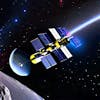S03E24: Cosmic Collaborations & Quantum Legacies: Japan's Lunar Footprint & Remembering Peter Higgs

**Host:** Charlie
---
**Episode Summary:**
Strap in for an interstellar expedition with Charlie on today's episode of Astronomy Daily - The Podcast, where we traverse the latest and most thrilling developments in space exploration. We'll witness...
**Host:** Charlie
---
**Episode Summary:**
Strap in for an interstellar expedition with Charlie on today's episode of Astronomy Daily - The Podcast, where we traverse the latest and most thrilling developments in space exploration. We'll witness history as a Japanese astronaut prepares to leave footprints on the lunar surface, delve into the high-stakes drama of Russia's Angara A-5 rocket, and marvel at groundbreaking studies that could transform lunar communication. We pay homage to the late Peter Higgs, whose legacy in particle physics continues to enlighten our cosmic comprehension. Plus, we celebrate the completion of the largest digital camera in astronomy, set to unveil the universe's darkest secrets. Join us as we navigate through these celestial milestones and the wonders beyond our atmosphere.
---
**Featured Topics:**
1. **Japanese Astronaut's Lunar Leap:** Learn about the historic moment as Japan joins the Artemis missions, paving the way for the first non-American astronaut to explore the moon's surface.
2. **Angara A-5's Third Launch Attempt:** Discover the significance of Russia's persistence with the Angara A-5 rocket and its implications for the nation's spacefaring future.
3. **Innovations in Lunar Communication:** Explore the potential of wireless power transmission to maintain contact with the far side of the moon, a technological breakthrough that could redefine space exploration.
4. **Remembering Peter Higgs:** Reflect on the life and enduring influence of Peter Higgs, whose work on the Higgs boson has shaped our understanding of the universe's fundamental forces.
5. **Astronomy's Largest Digital Camera:** Get a glimpse into the capabilities of the LSST camera, a monumental achievement that promises a new era of cosmic discovery.
---
**Additional Information:**
For an uninterrupted voyage through the cosmos, visit astronomydaily.io for a treasure trove of episodes and space news. Stay connected with fellow stargazers by following @astrodailypod on X (formerly Twitter). Don't miss a beat of the universe's rhythm by signing up for our free newsletter.
---
**Closing Remarks:**
As we bid farewell to another episode of Astronomy Daily, take a moment to ponder the boundless expanse of the cosmos and the human spirit that relentlessly seeks to understand it. Until our next celestial rendezvous, this is Charlie, your navigator through the stars, reminding you to keep the cosmos close to your heart. Clear skies and cosmic dreams to all!
---
**Host Sign-off:** Charlie: "Thank you for embarking on this cosmic journey with me. Until we reconvene under the vast cosmic canopy, this is Charlie, signing off. Remember, the universe beckons, and adventure awaits!"
For more visit www.astronomydaily.io
Become a supporter of this podcast: https://www.spreaker.com/podcast/astronomy-daily-the-podcast--5648921/support.
---
📋 Episode Chapters
(00:00) Welcome to another episode of Astronomy Daily podcast
(01:15) Japan and United States to collaborate on future lunar missions
(03:46) After two failed attempts, Russian space agency prepares for third launch attempt
(05:23) Polytechnique Montreal proposes wireless power transmission method for lunar exploration
(07:20) The Astronomy daily podcast pays tribute to late theoretical physicist Peter Higgs
For more Astronomy Daily, visit www.astronomydaily.io
Follow us on X (formerly twitter) @AstroDailyPod
This episode is brought to you with the support of NordPass...the password manager you need in your life. We know, we use it daily. For details on our really good deal, visit www.bitesz.com/nordpass
AI Transcript
Welcome to another episode of Astronomy Daily podcast
Charlie: Hello, stargazers and cosmic enthusiasts, and welcome to another episode of Astronomy Daily, the podcast, uh, your beacon through the expanses of the cosmos. I'm Charlie, your host, guiding you through the latest discoveries and breakthroughs in the world of astronomy. Today, we're gearing up for a stellar journey across the astronomical news landscape. From the momentous announcement of a japanese astronaut set to make history on the lunar surface to to the high stakes of Russia's Angara rocket, poised for its third launch attempt. We are going to explore the leaps and bounds happening right above our atmosphere. We'll also delve into the innovative studies that could revolutionize how we communicate with the far side of the moon and pay tribute to a giant of particle physics, Peter Higgs, whose eponymous boson has been pivotal in our understanding of the universe's building blocks. Plus, we'll celebrate an engineering marvel, the completion of astronomy's largest digital camera, that promises to expand our view of the cosmos like never before. Uh, so prepare for liftoff as we embark on this cosmic voyage through the mysteries, milestones, and marvels of our shared universe right here on astronomy daily.
Japan and United States to collaborate on future lunar missions
The podcast execute audio the astronomy daily podcast in a remarkable leap for international collaboration in space exploration, a japanese astronaut is poised to take a giant step for mankind, becoming the first non american space traveler to set foot on the moon. This historic undertaking is integrated into NASA's ambitious Artemis missions, marking a significant broadening of the horizons of lunar exploration. The announcement came as a laudatory highlight during Prime Minister Fumio Kishida's state visit. The United States, in an enduring bid to deepen ties with Japan, its pivotal asian ally, has extended an invitation that symbolises a, uh, stride forwards not just for the two nations, but for the international community at large. The partnership will see two japanese astronauts joining future Artemis missions, with one destined to etch a new chapter in the annals of lunar exploration. Facing the awe inspiring lunar surface, they will do so armed with contributions of technological prowess, including the provision of a moreover, designed for the challenging terrain of our celestial neighbour. This is not only a monumental breakthrough for Japan's space agency JAXA, which recently succeeded in their own lunar landing, but also a reflection of the ever growing cooperation that characterises humanity's quest to breach new frontiers. The shared endeavours and technological exchanges underscore a future where lunar expeditions are marked by global unity and collective efforts. The first mission to bring astronauts back to the moon's surface, Artemis III, is slated for 2026. Yet the significance of this announcement reaches beyond timelines and mission specifics. It resonates with the understanding that through diplomacy and discovery, our, uh, collective reach extends further into the cosmic ocean, unlocking the potential for an interconnected approach to unravelling the mysteries of our universe. With diversity and inclusion at the helm of the Artemis program, charting territories once touched only by Americans, this joint venture also resonates with NASA's message. America will no longer walk on the moon alone. Indeed, as we embark on this new era of space exploration, it becomes increasingly clear that our future amongst the stars will be woven from the fabric of international unity and shared dreams.
After two failed attempts, Russian space agency prepares for third launch attempt
In the vast forests of Russia's far east, a, uh, giant lies awaiting its moment to ascend the skies. This is the tale of the Angara a five space rocket. After two unsuccessful attempts marred by technical issues, the stage is set for a third launch endeavor that's critical not just for the rocket itself, but for Russia's lofty spacefaring ambitions. Much hangs in the balance at the Vostoghny Cosmodrome as Moscow prepares to assert its technological prowess with the scheduled relaunch of the Angara a five. While the world watches, engineers are diligently addressing the glitches. A, uh, stubborn engine start mechanism and a defiant valve. Undeniably minor in the grander scheme of space exploration, but significant enough to halt the mightiest of rockets. It's no mere test. It's a declaration of capability and a step toward autonomy in accessing space, a domain that has been shared, divided, and contended for. For the Angara a five, success means justifying the dedication of decades, the investments of billions, and President Vladimir Putin's vision of a reinvigorated russian presence amidst the stars. This third launch attempt embodies the resilience and quiet determination of the russian space agency, a reminder that in the realm of cosmic endeavors, perseverance is as valuable as the payload itself. As the nation reaches for a seamless launch with eyes set beyond Earth's confines, the Angara a five's journey may just foreshadow a new chapter in Russia's storied space history.
Polytechnique Montreal proposes wireless power transmission method for lunar exploration
The far side of the moon, always hidden from our view and thus from direct Earth communication, poses a significant challenge for explorers. Enter a game changing study from polytechnique Montreal, which might just have the solution to this conundrum. The team proposes a wireless power transmission method, harnessing technology that would be a leap forward in lunar exploration. Picture satellites orbiting at Earth Moon Lagrange, .2 acting as cosmic power lines, beaming energy to a solar powered receiver. This isn't science fiction, my dear listeners. This is scientific ingenuity at its finest. With WPT, astronauts could maintain unwavering contact with Earth, enabling missions to the moon's far side without the hindrance of energy constraints. It's not just about connectivity. It's about the scope of discovery. With constant power, rovers and instruments could probe the lunar mysteries that lay in the darkness, awaiting the light of human curiosity. The implications for upcoming Artemis missions are profound. We could establish a presence in those permanently shadowed regions, those untouched, ice filled craters where sunlight is a stranger. This study isn't merely an academic exercise. It's the sketching of humanity's future on a lunar canvas. The researchers, armed with calculations and simulations, suggest that a trio of satellites could provide uninterrupted energy, piercing through the silence that enshrouds our, uh, celestial neighbor's hidden face. Imagine, if you will, the audaciousness of embarking on a trek where the very essence of exploration, energy, is no longer a tether back to base, but a constant companion. As we stand on the cusp of unravelling the universe's secrets, innovations like wireless power transmission ensure we don't just touch the stars, but communicate with them, too. Stay with us as we continue our journey into these bold new realms of space exploration.
The Astronomy daily podcast pays tribute to late theoretical physicist Peter Higgs
The Astronomy daily podcast today, we honour the memory of Professor Peter Higgs, the groundbreaking theoretical physicist who passed away at the age of 94. Known for his revolutionary work, Higgs imparted a profound impact on our understanding of the universe's fundamental particles. His name became synonymous with the elusive Higgs boson, the particle responsible for giving mass to other particles, a cornerstone of the standard model of particle physics. It was in 1964 when Higgs, alongside other brilliant minds, proposed the existence of the Higgs field, an energetic tapestry permeating space, endowing particles with mass. The confirmation of this theory would not come until 2012, when the large hadron collider at CERN detected signs of the Higgs boson. After decades of pursuit, this monumental discovery solidified Higgs towering theoretical predictions, earning him a Nobel Prize in physics. The revelation of the Higgs boson has compelled physicists to now explore beyond the edges of current understanding, signposting uncharted avenues of physics yet to be discovered. The implications of his work ripple far beyond the accolades. They lay the framework for aspiring generations to quest after the hidden realms of our universe. In losing Peter Higgs, we are reminded of his humility amidst great acclaim and his tireless curiosity that captured the imagination of scientists the world over. His legacy, encapsulated in a particle so fundamental, continues to inspire a relentless pursuit of knowledge in the mysterious quantum domain. Astronomy aficionados prepare to be dazzled. The world of cosmology has hit a monumental milestone with the completion of the LSST camera, the largest digital camera ever built for the intricate tapestry of the cosmos. This 3200 megapixel behemoth, a marvel of scientific endeavor, will soon be nestled in the peaks of the chilean Andes, poised to capture the universe with an unprecedented precision. Its to peel back the curtains of our cosmic stage and offer insights into the enigmatic players known as dark matter and dark energy. As a sentinel perched atop the Vera C Rubin observatory, this camera is our ticket to a ten year cinematic journey across the southern night sky. With every snapshot, its treasure trove of data will resemble the stardust from which stories of the universe are spun. This intricate device, roughly the size of a small car and imbued with the finesse of capturing a golf ball some 15 miles away, stands ready to deliver a deluge of discoveries. Imagine a field of vision so vast that it encompasses a sky area seven times wider than the full moon, detailed enough that it warrants hundreds of high definition screens to display a single full size image. It's an exciting time to gaze upwards as we stand on the cusp of enhancing our understanding of the universe. The LSST camera isn't merely a tool for observation. It is a key that will unlock realms beyond the visible, shedding light on the celestial dark mysteries that have puzzled astronomers and physicists alike. With this camera, the stage is set, and the universe in all its glory, awaits its grand, pixel perfect portrait. And just like the stars that eventually retreat beyond the horizon at dawn, we've reached the end of another fascinating journey across the cosmos. Thank you for joining me on today's episode of Astronomy Daily, the podcast where we've circumnavigated the latest astronomical discoveries and breakthroughs. Before we part ways, I would like to extend a warm invitation to visit our website at astronomydaily IO. There, you can plunge deeper into the celestial ocean by listening to past episodes to continue your odyssey into the marvels of our universe. The latest space news awaits you as well, keeping you abreast of all things astronomical while your curiosity can be further satiated by signing up for our free daily newsletter and for a daily dose of the cosmos through your social feed, follow us on X, formally known as Twitter. Just search for Astro Dailypod and join a community of fellow space enthusiasts until our, uh, next stellar encounter. Keep your eyes on the skies and your heart filled with wonder. This is Charlie, your host for astronomy daily, the podcast signing off.
New to Astronomy Daily - The Podcast?
Here are some great episodes to start with.














